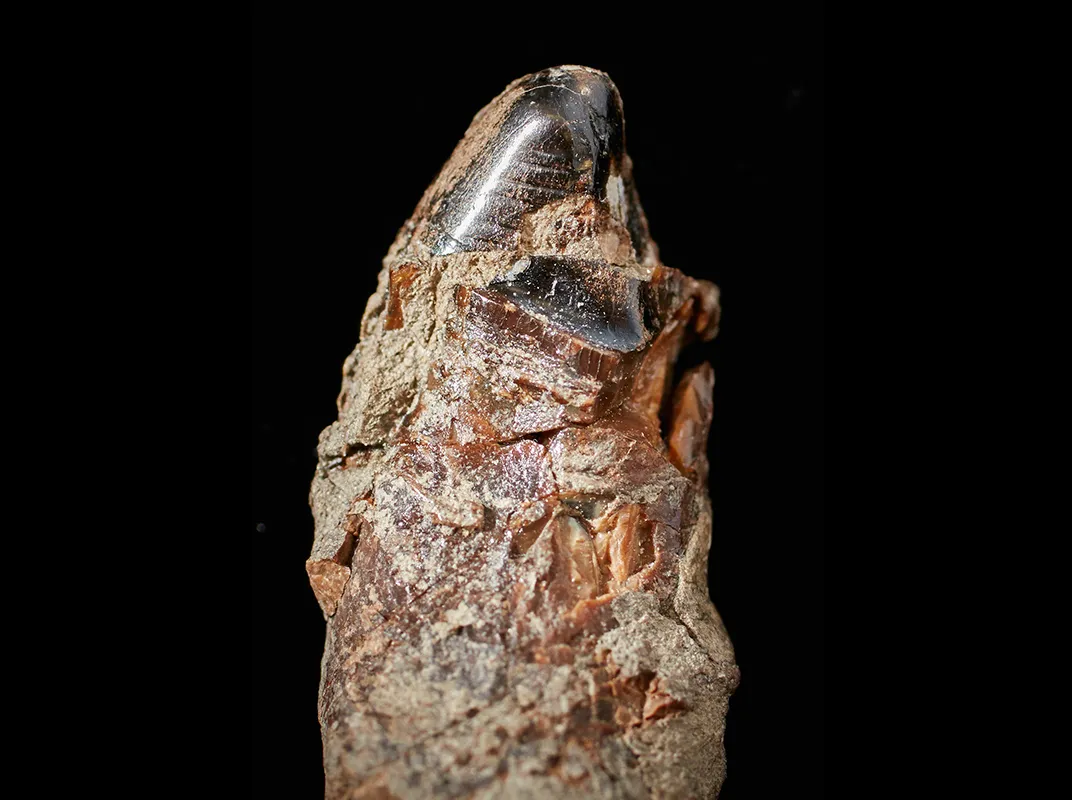The Earliest Baleen Whales Literally Sucked
No offense to toothy whale ancestors
/https://tf-cmsv2-smithsonianmag-media.s3.amazonaws.com/filer/22/ae/22aeea66-5582-4c3f-9a8d-bc27f6dd95a5/dr_erich_fitzgerald_and_tim_ziegler_with_a_3d_model_of_alfreds_skull_credit_ben_healley.jpg)
If there were an Olympic medal for competitive eating, it would go to a baleen whale. Just look at the blue whale: The largest animal on the planet, this ravenous creature can scarf down over 457,000 calories in a single mouthful, straining seawater through its mouth to catch krill and other tasty little morsels. But how did these ocean giants evolve their impressively efficient (if not exactly well-mannered) method of slurping up huge mouthfuls of tiny prey?
A recently-discovered fossil whale presents an unexpected answer: Early baleen whales sucked. (That’s no disrespect intended to whale ancestors.)
Even though today’s baleen whales—which include blue whales, humpback whales and minke whales—get their family name from the peculiar array of bristles that allow them to filter food out of the water, the earliest members of their family actually had mouths filled with teeth. The 25 million-year-old Janjucetus, for example, had a sharp smile of recurved choppers without a trace of baleen to be seen.
Later members of the same group, known as mysticetes, may have had a mixture of teeth and tufts of baleen. (Baleen, by the way, is made of keratin, the tough protein found in fingernails, hair and ant exoskeletons.) Even though the baleen itself hasn’t been found in the oldest fossil whales, like the 23-million-year-old species of Aetiocetus, clues such as blood vessel openings on the rooves of their mouths have led researchers to hypothesize its presence. Drawing from these fossils, paleontologists proposed two scenarios for how mysticetes may have switched from teeth to baleen, says paleontologist Erich Fitzgerald of the Museum Victoria.
One idea was that the ancestors of today’s baleen whales had interlocking teeth, which they used to strain small fish out of the water, as crabeater seals do today. Yet there’s no solid evidence to suggest that whales like Janjucetus did this. The possible tooth-and-baleen mixture in Aetiocetus seemed a more likely option, with baleen becoming more and more important to catching little tidbits through time, but Fitzgerald points out that no one has yet found conclusive evidence that Aetiocetus had baleen. Seals and other marine mammals have similar openings on the rooves of their mouths, even though they lack baleen.
When, why and how baleen whales evolved the distinctive bristles that give them their name remained unclear.

Enter Alfred. That’s the name of a 25-million-year-old whale found along Washington’s Olympic Peninsula in 2004. It got its nickname, Fitzgerald says, simply because colleague Felix Marx thought Alfred was a fitting title for the new aetiocetid. But even though Alfred doesn’t yet have an official scientific moniker, Fitzgerald could see that it was something special even before the whale had fully emerged from the stone that encased it.
“Alfred’s teeth were preserved loose in soft sediment alongside the skull,” Fitzgerald says, “and as we were disaggregating blocks of sediment in buckets of hot water, some teeth dropped out to the bottom of the bucket.” Fitzgerald could immediately tell there was something odd going on; one tooth had horizontal scratch marks along the crown. Museum Victoria lab technician Tim Ziegler soon found other examples during the preparation process, Fitzgerald says, all with telltale scratches on the tongue-side of the teeth.
Fitzgerald had seen this before. Modern walrus show similar dental damage from scraping sediment along their teeth as they move their tongues back and forth to suck prey into their mouths. “In that moment of insight,” Fitzgerald says, “the team realized that we could have direct evidence of suction feeding behavior” in this ancient baleen whale. The researchers report their results in a new Memoirs of Museum Victoria study.
Fitzgerald had raised the possibility that another ancient mysticete, called Mammalodon, might have nabbed lunch by suction. But, he says, Alfred’s scratched teeth are “the smoking gun of suction feeding.” This ancient whale flung open its toothy jaws to create a little vacuum, drawing in prey as well as sediment—just as toothed whales like belugas do today. “Our team suspects that other aetiocetids, perhaps all aetiocetids, were suction feeders,” Fitzgerald says, “but it is only Alfred that has preserved the rare clinching evidence for this prey capture method.”
Alfred opens a new possibility for how whales lost their teeth. In short, teeth would have only gotten in the way. “Ancient toothed baleen whales first became suction feeders,” Fitzgerald says, “which resulted in a reduced need for teeth to bite prey, and paved the way for loss of teeth and the modification of gums to form a baleen filter for prey that was sucked in to the mouth.” Teeth could have acted as a simple sieve to start. But a curtain of baleen would have been even better, starting these whales on their path to delicately sifting the seas.
/https://tf-cmsv2-smithsonianmag-media.s3.amazonaws.com/accounts/headshot/RileyBlack.png)
/https://tf-cmsv2-smithsonianmag-media.s3.amazonaws.com/accounts/headshot/RileyBlack.png)